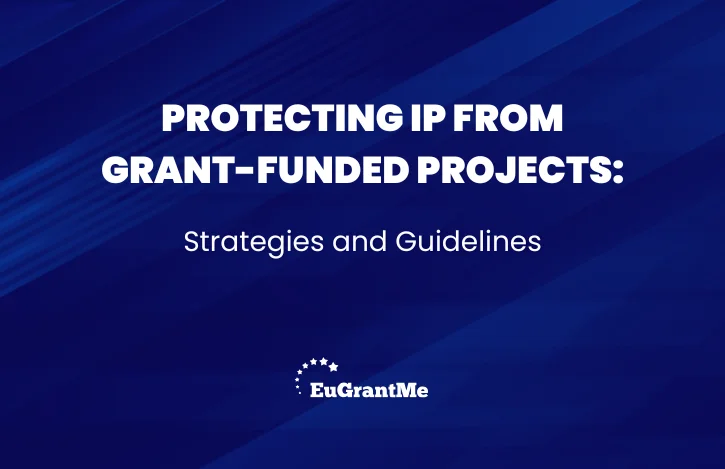When engaging in grant-funded projects, protecting intellectual property (IP) is crucial. The landscape of innovation is competitive, and safeguarding your ideas ensures long-term success. Understanding how to effectively protect IP from grant-funded projects can make a significant difference. This article outlines strategies and guidelines to help you navigate the complexities of IP protection while pursuing grant funding.
Understanding Intellectual Property
Intellectual property refers to creations of the mind. This includes inventions, designs, and artistic works. IP protection grants creators exclusive rights to their innovations. This exclusivity is essential for fostering innovation and encouraging investment. In grant-funded projects, properly managing IP can enhance your organisation’s credibility and value.
Different types of IP require different protection strategies. Patents protect inventions, while trademarks safeguard brands. Copyrights cover artistic and literary works. Understanding these distinctions is vital for determining how to protect your specific innovations effectively.
Importance of IP Protection in Grant-Funded Projects
Securing IP protection is especially important in grant-funded projects. Funders often expect projects to generate new knowledge or products. Without proper protection, organisations risk losing control over their innovations. This can lead to potential misuse by competitors or loss of future revenue.
Additionally, having a solid IP strategy can enhance your funding application. Funders may view strong IP management as a sign of professionalism and preparedness. Thus, investing time and resources in IP protection can be beneficial for your project.
Developing an IP Strategy
Creating an effective IP strategy is the first step in protecting your innovations. Start by identifying the types of IP your project will generate. This may include patents for new technologies, trademarks for branding, or copyrights for software or documentation.
Next, assess the potential value of your IP. Consider how your innovations can be commercialised and the competitive advantages they offer. This assessment will guide your decisions regarding IP protection.
Moreover, establish a timeline for IP protection. Different types of IP require different processes. For instance, patent applications can take several years, while trademark registration is generally quicker. Planning these timelines will help you integrate IP protection into your project’s overall schedule.
Conducting an IP Audit
An IP audit is a systematic review of your organisation’s IP assets. Conducting an IP audit helps identify existing IP, potential risks, and opportunities for protection. This assessment is crucial before launching a grant-funded project.
During the audit, catalogue all existing IP and determine its protection status. Identify any gaps in protection and prioritise actions to address these gaps. This may involve filing for patents or registering trademarks.
Regularly conducting IP audits can also help maintain awareness of your organisation’s IP landscape. This ongoing vigilance ensures you can respond promptly to potential threats or opportunities.
Collaboration and IP Agreements
Many grant-funded projects involve collaboration with other organisations or individuals. It is essential to establish clear IP agreements when entering partnerships. These agreements should outline ownership rights, responsibilities, and usage terms for any jointly developed IP.
Negotiating IP terms upfront can prevent misunderstandings later in the project. Additionally, formalising agreements in writing ensures all parties are on the same page regarding their rights and obligations. This clarity can foster a positive collaborative environment and protect your interests.
Protecting Trade Secrets
In addition to formal IP protections, maintaining trade secrets is crucial. Trade secrets can include processes, formulas, or techniques that give your organisation a competitive edge. Unlike patents, trade secrets do not require formal registration, but they must be actively protected.
Implementing non-disclosure agreements (NDAs) is one effective way to safeguard trade secrets. NDAs can help ensure that collaborators, employees, and external partners do not disclose sensitive information. Additionally, establishing internal protocols for handling confidential information is essential.
Engaging Legal Expertise
Navigating IP protection can be complex. Engaging legal experts in intellectual property is advisable. These professionals can provide valuable guidance on best practices and ensure compliance with relevant laws.
A lawyer can help with drafting and reviewing IP agreements, as well as advising on filing patents and trademarks. Their expertise can enhance your IP strategy and minimise potential risks.
Keeping Records
Maintaining thorough records is essential for protecting IP in grant-funded projects. Documenting the development process can help establish ownership and date of creation. This information can be invaluable in case of disputes over IP rights.
Additionally, keeping detailed records of any agreements related to IP can safeguard your interests. This documentation ensures you can refer to specific terms and conditions if needed.
Monitoring and Enforcement
Once you have established IP protections, ongoing monitoring is crucial. Regularly check for potential infringements on your IP rights. This vigilance can help you address issues before they escalate.
If you discover infringements, take appropriate action to enforce your rights. This may involve sending cease-and-desist letters or pursuing legal action. Acting quickly demonstrates your commitment to protecting your IP and can deter future violations.
In conclusion, protecting IP from grant-funded projects is essential for long-term success. By developing a comprehensive IP strategy, conducting audits, and establishing clear agreements, organisations can safeguard their innovations effectively. Engaging legal expertise and maintaining thorough records further enhances IP protection efforts.
Ultimately, a strong focus on IP protection will not only support the success of your grant-funded projects but also contribute to your organisation’s overall growth and competitiveness. By prioritising these strategies and guidelines, you can navigate the complexities of IP in grant-funded environments successfully.
At EuGrantMe, we are passionate about fostering innovation and empowering ambitious minds to flourish. Our mission revolves around providing top-notch grant writing services for the EIC Accelerator and Horizon grants in Europe. We enable our customers to unlock the full potential of their ground-breaking ideas.
Do you have a project to turn into reality?
Contact us!


